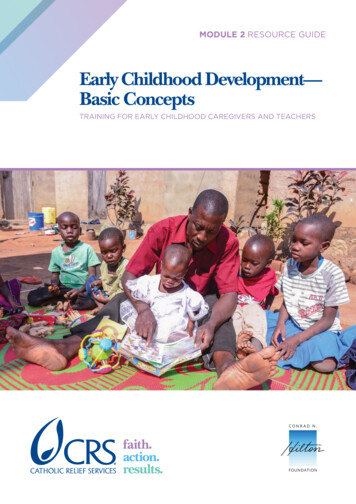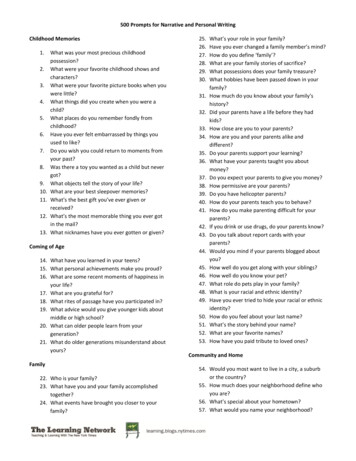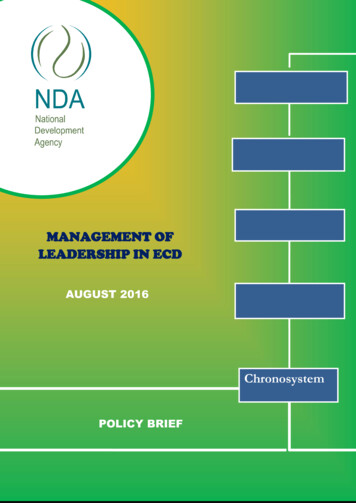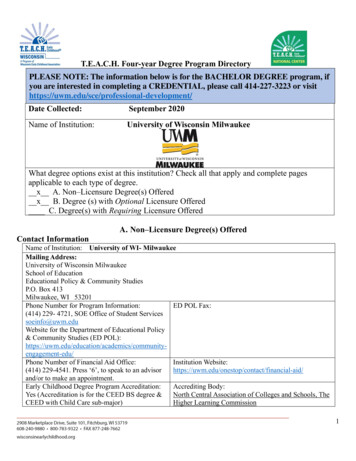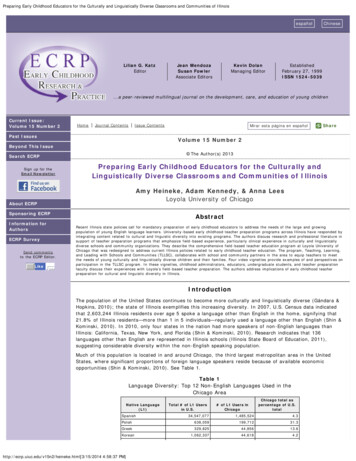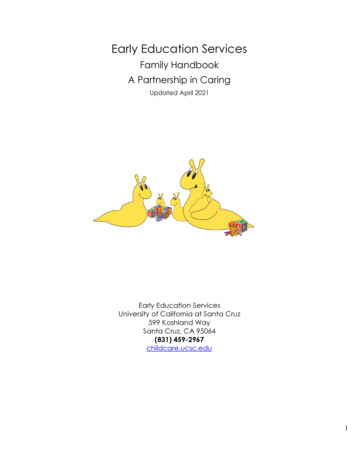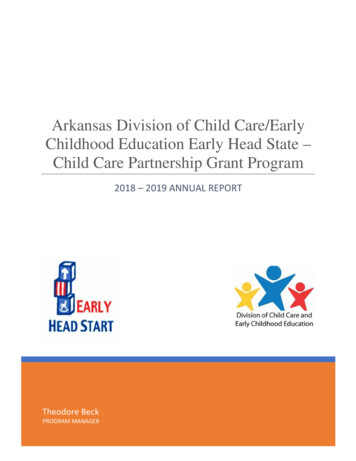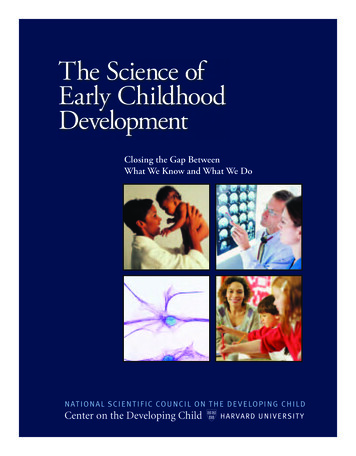
Transcription
The Science ofEarly ChildhoodDevelopmentClosing the Gap BetweenWhat We Know and What We Do
Council MembersJack P. Shonkoff, M.D., ChairJulius B. Richmond FAMRI Professorof Child Health and DevelopmentDirector, Center on the Developing Child,Harvard UniversityW. Thomas Boyce, M.D.Sunny Hill Health Centre/BC LeadershipChair in Child DevelopmentProfessor, Graduate Studies and Medicine,University of British Columbia, VancouverJudy Cameron, Ph.D.Professor of Psychiatry, University of PittsburghSenior Scientist, Oregon NationalPrimate Research CenterProfessor of Behavioral Neuroscienceand Obstetrics & Gynecology,Oregon Health and Science UniversityGreg Duncan, Ph.D.Edwina S. Tarry Professor of HumanDevelopment and Social PolicyFaculty Fellow, Institute for Policy Research,Northwestern UniversityNathan A. Fox, Ph.D.Professor of Human Development,University of Maryland College ParkWilliam Greenough, Ph.D.Swanlund Professor of Psychology, Psychiatry,and Cell and Developmental BiologyDirector, Center for Advanced Study atUniversity of Illinois, Urbana-ChampaignMegan Gunnar, Ph.D.Regents Professor and DistinguishedMcKnight University Professor,Institute of Child Development,University of MinnesotaEric Knudsen, Ph.D.Edward C. and Amy H. SewallProfessor of Neurobiology,Stanford University School of MedicineCharles A. Nelson, Ph.D.Richard David Scott Chair in PediatricDevelopmental Medicine Research,Children’s Hospital BostonProfessor of Pediatrics,Harvard Medical SchoolDeborah Phillips, Ph.D.Professor of Psychology and AssociatedFaculty, Public Policy InstituteCo-Director, Research Centeron Children in the U.S.,Georgetown UniversityRoss Thompson, Ph.D.Professor of Psychology,University of California, DavisContributing MembersSusan Nall BalesPresident, FrameWorks InstituteJames J. Heckman, Ph.D.Henry Schultz DistinguishedService Professor of Economics,University of ChicagoBruce S. McEwen, Ph.D.Alfred E. Mirsky ProfessorHead, Harold and Margaret Milliken HatchLaboratory of Neuroendocrinology,The Rockefeller UniversityArthur J. Rolnick, Ph.D.Senior Vice President and Director of Research,Federal Reserve Bank of MinneapolisCouncil PartnersThe FrameWorks InstituteThe Johnson & Johnson Pediatric InstitutePat Levitt, Ph.D.Professor of PharmacologyAnnette Schaffer Eskind Chair andDirector, Kennedy Center for Researchon Human Development,Vanderbilt UniversityThe National Conference of State LegislaturesBetsy Lozoff, M.D.Professor of Pediatrics, University ofMichigan Medical SchoolResearch Professor, Center forHuman Growth and Development,University of MichiganThe Pierre and Pamela Omidyar FundCouncil SponsorsThe Buffett Early Childhood FundThe John D. and Catherine T. MacArthur FoundationSuggested citation: The Science of Early Childhood Development. (2007)National Scientific Council on the Developing Child. http://www.developingchild.net January 2007 NATIONAL SCIENTIFIC COUNCIL ON THE DEVELOPING CHILDSecond Printing—November 2007coreconcept 23.indd 29/24/07 9:47:53 AM
Executive SummaryThe future of any society depends on its ability to foster the health and well-being of the nextgeneration. Stated simply, today’s children will become tomorrow’s citizens, workers, and parents. When we invest wisely in children and families, the next generation will pay that backthrough a lifetime of productivity and responsible citizenship. When we fail to provide children with what they need to build a strong foundation for healthy and productive lives, we put ourfuture prosperity and security at risk.Two recent developments have stimulated growing public discussion aboutthe right balance between individual and shared responsibility for that strongfoundation. The first is the explosion of research in neurobiology that clarifies the extent to which the interaction between genetics and early experienceliterally shapes brain architecture. The second is the increasingly recognizedneed for a highly skilled workforce and healthy adult population to confrontthe growing challenges of global economic competition and the rising costs ofSocial Security, Medicare, and Medicaid for the aging baby boomers.In an effort to identify those aspects of development that are accepted broadly by the scientific community, the National Scientific Council, based at theCenter on the Developing Child at Harvard University, brought togetherseveral of the nation’s leading neuroscientists, developmental psychologists,pediatricians, and economists. This document presents their critical reviewof the existing literatures in their fields and a consensus about what we nowknow about development in the early childhood years. The objective of the Council is to move beyondthe public’s fascination with “the latest study” and focus on the cumulative knowledge of decades of research that has been subjected to rigorous and continuous peer review. The goal of this document is tohelp the public and its policy makers understand the core principles of that body of work that are nowsufficiently accepted across the scientific community to warrant public action.It is our hope and belief that better public understanding of the rapidly growing science of earlychildhood and early brain development can provide a powerful impetus for the design and implementation of policies and programs that could make a significant difference in the lives of all children. Without that understanding, investments that could generate significant returns for all of society stand therisk of being rejected or undermined. Thus, there is a compelling need for scientists to share with thepublic and its representatives an objective basis for choosing wisely among competing demands on limited resources.This paper is designed to provide a framework within which this complex challenge can be addressedmost effectively. Its goal is to promote an understanding of the basic science of early childhood development, including its underlying neurobiology, to inform both public and private sector investment inyoung children and their families. To this end, the paper presents a set of core developmental conceptsthat have emerged from decades of rigorous research in neurobiology, developmental psychology, andthe economics of human capital formation, and considers their implications for a range of issues in policy and practice.Core Concepts of Development Child development is a foundation for community development and economic development, as capablechildren become the foundation of a prosperous and sustainable society. Brains are built over time. The interactive influences of genes and experience literally shape the architecture of the developing brain,and the active ingredient is the “serve and return” nature of children’s engagement in relationships withtheir parents and other caregivers in their family or community.www.developingchild.netcoreconcept 23.indd 1 9/24/07 9:47:55 AM
Both brain architecture and developing abilities are built “from the bottom up,” with simple circuitsand skills providing the scaffolding for more advanced circuits and skills over time. Toxic stress in early childhood is associated with persistent effects on the nervous system and stresshormone systems that can damage developing brain architecture and lead to lifelong problems inlearning, behavior, and both physical and mental health. Creating the right conditions for early childhood development is likely to be more effective and lesscostly than addressing problems at a later age.Implications for Policy and Practice Policy initiatives that promote supportive relationships and richlearning opportunities for young children create a strong foundation for higher school achievement followed by greater productivityin the workplace and solid citizenship in the community. Substantial progress toward this goal can be achieved by assuringgrowth-promoting experiences both at home and in communitybased settings, through a range of parent education, family support,early care and education, preschool, and intervention services. When parents, informal community programs, and professionallystaffed early childhood services pay attention to young children’semotional and social needs, as well as to their mastery of literacy andcognitive skills, they have maximum impact on the development ofsturdy brain architecture and preparation for success in school. When basic health and early childhood programs monitor the development of all children, problems that require attention can beidentified in a timely fashion and intervention can be provided. The basic principles of neuroscience and the technology of humanskill formation indicate that later remediation for highly vulnerable children will produce less favorable outcomes and cost morethan appropriate intervention at a younger age. The essence of quality in early childhood services is embodied in the expertise and skills of the staffand in their capacity to build positive relationships with young children. The striking shortage of welltrained personnel in the field today indicates that substantial investments in training, recruiting, compensating, and retaining a high quality workforce must be a top priority. Responsible investments in services for young children and their families focus on benefits relativeto cost. Inexpensive services that do not meet quality standards are a waste of money. Stated simply,sound policies seek maximum value rather than minimal cost.The need to address significant inequalities in opportunity, beginning in the earliest years of life, isboth a fundamental moral responsibility and a critical investment in our nation’s social and economic future. Thus, the time has come to close the gap between what we know (from systematic scientific inquiryacross a broad range of disciplines) and what we do (through both public and private sector policies andpractices) to promote the healthy development of all young children. The science of early childhood development can provide a powerful framework for informing sound choices among alternative prioritiesand for building consensus around a shared plan of action. The well-being of our nation’s children andthe security of its future would be well-served by such wise choices and concerted commitment. coreconcept 23.indd 2www.developingchild.net9/24/07 9:47:56 AM
The Science ofEarly Childhood DevelopmentThe future of any society depends on its ability to foster the health and well-being of the nextgeneration. Stated simply, today’s children will become tomorrow’s citizens, workers, andparents. When we fail to provide children with what they need to build a strong foundation for healthy and productive lives, weput our future prosperity and security at risk.Science has a lot to offer about how we as a community can use our collective resources most effectively andefficiently to build that strong foundation. When we invest wisely in children and families, the next generationwill pay that back through a lifetime of productivity andresponsible citizenship. When we do not make wise investments in the earliest years, we will all pay the considerable costs of greater numbers of school-aged children who need special education and more adults whoare under-employable, unemployable, or incarcerated.Two recent developments have stimulated growingpublic discussion about the right balance between individual and shared responsibility for child well-being.The first is the explosion of research in neuroscienceand other developmental sciences that highlights theextent to which the interaction between genetics andearly experience creates either a sturdy or weak foundation for all the learning, behavior, and health thatfollow. The second is the increasingly recognized need for a highly skilled workforce and healthy adultpopulation to confront the growing challenges of global economic competition and the rising costs ofSocial Security, Medicare, and Medicaid for the aging baby boomers.Most policy makers who face decisions among competing actions lack both the time and means tosecure sound scientific advice about which investments offer the greatest potential value and what program elements are critical to their effectiveness. Those same policy makers must explain their decisionsto business executives and civic leaders who hold a wide range of beliefs about child-rearing and developmental influences. Without better public understanding of the science of early childhood and braindevelopment, policies and programs that could makea significant difference in the lives of children and allof society stand the risk of being rejected or undermined. Thus, there is a compelling need to educatethe public and its representatives about how to choosewisely among competing demands.For some, the most important decisions focus on theallocation of resources among alternative approachesdefined by need (e.g., universal versus targeted investments) or age (e.g., pre-K for four-year-olds versus parent support programs beginning at birth). Others move quickly to questions about the relative merits of different program models. Some are interestedprimarily in the results of benefit-cost analyses. Others view the reduction of inequalities in opportunityWhen we invest wisely inchildren and families, the nextgeneration will pay that backthrough a lifetime of productivityand responsible citizenship.www.developingchild.netcoreconcept 23.indd 3 9/24/07 9:47:59 AM
as a moral imperative. All are united in the responsibilityto assure that limited resources are invested wisely.Regardless of the questions, it is essential that the answers be grounded in accurate scientific knowledge whereit is available and sound professional judgment when it isneeded. This is particularly important in the face of inevitable debates over alternative interpretations of the mountains of program evaluation data generated in a policy environment characterized by ideological differences aboutthe means and ends of raising young children.In October 2000, the Institute of Medicine and National Research Council of the National Academy of Sciences released a report entitled From Neurons to Neighborhoods: The Science of Early Childhood Development. Thefinal paragraph of that 588-page report presented a compelling challenge:The charge to this committee was to blend the knowledgeand insights of a broad range of disciplines to generate an integrated science of early childhood development. The charge to society is to blend the skepticism of a scientist,the passion of an advocate, the pragmatism of a policy maker, the creativity of a practitioner, and the devotionof a parent—and to use existing knowledge to ensure both a decent quality of life for all of our children anda promising future for the nation.This paper is designed to provide a framework within which this complex charge can be addressedmost effectively. Its goal is to promote an understanding of the basic science of early childhood development, including its underlying neurobiology, to inform both public and private sector investment inyoung children and their families. To this end, the paper presents a set of core developmental conceptsthat have emerged from decades of rigorous research in neuroscience, developmental psychology, andthe economics of human capital formation—and that have survived a rigorous process of debate amongthe members of the National Scientific Council on the Developing Child about what science can tell usabout brain architecture and the foundations of learning, behavior, and health.Core Concepts of DevelopmentConcept 1: Child development is a foundation for community develop-ment and economic development, as capable children become the foundation of a prosperous andsustainable society.The early development of cognitive skills, emotional well-being, social competence, and sound physicaland mental health builds a strong foundation for success well into the adult years. Beyond their shortterm importance for positive school achievement, these abilities are critical prerequisites for economicproductivity and responsible citizenship throughout life. All aspects of adult human capital, from workforce skills to cooperative and lawful behavior, build on capacities that are developed during childhood,beginning at birth.Implications for Policy and Practice Policy initiatives that promote supportive relationships and rich learning opportunities for young childrencreate a strong foundation for higher school achievement followed by greater productivity in the workplace and solid citizenship in the community throughout the adult years. Thus, current calls for greateremphasis on early literacy must not diminish the importance of attention to other essential capacities, coreconcept 23.indd 4www.developingchild.net9/24/07 9:48:01 AM
such as initiative, self-confidence, and persistence in learning, as well as the ability to work cooperativelyand resolve conflict with peers—all of which are core characteristics of students in a successful school, citizens in a healthy community, and the workforce of a prosperous nation. All of society would benefit from a coordinated effort toreduce significant inequalities in the skills of young children at school entry. Substantial progress toward this goalcan be achieved by assuring high quality early learning experiences both at home and in community-based settings,through a range of parent education, family support, earlycare and education, preschool, and intervention services.All aspects of adult humancapital, from work force skillsto cooperative and lawfulbehavior, build on capacitiesthat are developed duringchildhood, beginning at birth. This calls for a long-term investment by all segments ofsociety—including the business community, private philanthropy, both faith-based and secular voluntary organizations, professional associations, and government at all levels—to work together to strengthen families, educate mothers and fathers, and provide professional assistance for those young childrenand their parents who need help. In fact, the future vitality of the institutions that each these sectors represent will depend on the wisdom of their investment, as today’s children either take up society’s important work and roles as adults or are ill-prepared and unable to do so. Effective early childhood policies and practices will not eliminate all social and economic inequalities.However, when successful interventions are followed by continuing investments throughout the childhood years, they increase the odds that many more children will grow up to be adults who contribute positively to their communities and raise healthy and competent children themselves, while many fewer willend up on public assistance or in jail.Concept 2: Brains are built over time.The basic architecture of the brain is constructed through an ongoingprocess that begins before birth and continues into adulthood. Likethe construction of a home, the building process begins with laying thefoundation, framing the rooms, and wiring the electrical system in apredictable sequence, and it continues with the incorporation of distinctive features that reflect increasing individuality over time. Brainarchitecture is built over a succession of “sensitive periods,” each ofwhich is associated with the formation of specific circuits that are associated with specific abilities. The development of increasingly complexskills and their underlying circuits builds on the circuits and skills thatwere formed earlier. Through this process, early experiences create afoundation for lifelong learning, behavior, and both physical and mental health. A strong foundation in the early years increases the probability of positive outcomes and a weak foundation increases the oddsof later difficulties.Implications for Policy and Practice When systems are put in place to monitor the development of all children continuously over time,problems that require attention can be identified early and appropriate responses can be made. This canbe accomplished by appropriately trained physicians, nurse practitioners, or developmental specialistswithin the context of regular health care, as well as through the ongoing observations of skilled providers of early care and education. Fully meeting this goal requires prenatal care for all pregnant womenand sustained access to a consistent source of primary health care for all children.www.developingchild.netcoreconcept 23.indd 5 9/24/07 9:48:03 AM
Environmental protection policies needcontinuous updating and enforcementif they are to succeed in reducing prenatal and early childhood exposures to substances that have clearly documented toxic effects on the immature brain. Theseinclude mercury in fish, lead in soil, andorganophosphates in insecticides, amongmany others. The fact that fetal exposure to alcohol isthe leading preventable cause of mentalretardation in the United States directsour attention to the need for new and creative efforts to reduce alcohol consumption during pregnancy.Concept 3: The interactive influences of genes and experience literallyshape the architecture of the developing brain, and the active ingredient is the “serve and return”nature of children’s engagement in relationships with their parents and other caregivers in theirfamily or community.The architecture of the brain is composed of highly integrated sets of neural circuits (i.e., connectionsamong brain cells) that are “wired” under the continuous and mutual influences of both genetics andenvironment. Genes determine when specific brain circuits are formed and individual experiences thenshape how that formation unfolds. This developmental process is fueled by a self-initiated, inborn drivetoward competence that is an essential characteristic of human nature. Appropriate sensory input (e.g.,through hearing and vision) and stable, responsive relationships build healthy brain architecture thatprovides a strong foundation for lifelong learning, behavior, and health. The most important relationships begin in the family but often also involve other adults who play important roles in the lives ofyoung children, including providers of early care and education.What scientists refer to as interaction, mutuality, and reciprocity can be understood as comparableto the process of “serve and return” in games such as tennis and volleyball. In early childhood development, serve and return happens when young children naturally reach out for interaction through babbling, facial expressions, words, gestures, and cries, and adults respond by getting in sync and doing thesame kind of vocalizing and gesturing back at them, and the process continues back and forth. Anotherimportant aspect of the serve and return notion of interaction is that it works best when it is embeddedin an ongoing relationship between a child and an adult who is responsive to the child’s own unique individuality. Decades of research tell us that mutually rewarding interactions are essential prerequisitesfor the development of healthy brain circuits and increasingly complex skills.Implications for Policy and Practice Healthy communities foster the development of healthy children through the informal support that families provide for each other. When parents are inexperienced in child-rearing or overwhelmed by economicinsecurity or threatening community conditions, effective parent education and family support programscan help them sustain the kinds of growth-promoting experiences that build child competence andshape healthy brain architecture. When informal supports and community programs are not sufficient,professional assistance can make an important difference in preventing the formation of faulty brain circuits and the developmental problems that follow. However, professionals with appropriate expertise arerelatively limited in number, and their availability will require significant investment in specialized training, coreconcept 23.indd 6www.developingchild.net9/24/07 9:48:05 AM
particularly in the domains of maternal and early childhood mental health.Increasingly complex skillsbuild on the more basic,foundational capabilitiesthat precede them. Business executives, civic leaders, and government officials at all levels should work together to develop better private sector and public policies to provide parentswith more viable choices about how to balance theirwork and parenting responsibilities after the birth ofa baby or adoption of a child. During early infancy,when parent-child bonding and emerging attachments are so important, there is a pressing need to strikea better balance between options that support parents to care for their babies at home and those that provide affordable, quality child care for parents who return to work or attend school. This also calls our attention to the need for a more child-oriented perspective on the implications of mandated employmentfor mothers of very young children who receive welfare support. The important influence of positive relationships in shaping the architecture of the developing brainindicates that all of society would benefit from better trained personnel in early child care settings, aswell as reduced staff turnover rates which currently undermine the relationships that young childrenhave with the adults who provide much of their daily care. Policy makers should examine the potential impact of alternative strategies for increasing the retention of qualified staff, such as competitivesalaries and benefits, opportunities for career advancement linked to additional education, and greaterrespect for their work as a valued profession. Promising initiatives can be modeled after the successfulinvestments made by the U.S. Department of Defense, which has a very high quality system of earlycare and education.Concept 4: Both brain architecture and developing abilities are built“from the bottom up,” with simple circuits and skills providing the scaffolding for more advancedcircuits and skills over time.Brain circuits that process basic information are wired earlier than those that process more complex information. Higher level circuits build on lower level circuits, and adaptation at higher levels is moredifficult if lower level circuitswere not wired properly. Parallelto the construction of brain circuits, increasingly complex skillsbuild on the more basic, foundational capabilities that precedethem. For example, the abilityto understand and then say thenames of objects depends uponearlier development of the capacity to differentiate and reproduce the sounds of one’s nativelanguage. And the circuits thatunderlie the ability to put wordstogether to speak in phrases forma foundation for the subsequentmastery of reading a written sentence in a book. Stated in simpleterms, circuits build on circuitsand skill begets skill.www.developingchild.netcoreconcept 23.indd 7 9/24/07 9:48:08 AM
Implications for Policy and Practice Policy makers should consider increasing the availability of parent education and family support programsthat have been demonstrated to be effective. These services should begin soon after birth for mothers andfathers with limited education to help them create a home environment that provides the kind of richlanguage exposure, positive social interactions, and early literacy experiences that increase the probability that their child will enter school with the skills needed tosucceed. When children are born under significantly adversecircumstances, immediate intervention is warranted, including prenatal support services where feasible. Effective programscan be provided through voluntary associations, communitybased organizations, and employer-sponsored initiatives, aswell as through government-funded services. Evidence-basedsupports that are provided earlier rather than later will have thegreatest impact, as they help establish healthy brain architecture during the period when lower-level circuits are being constructed (even before birth), thereby creating a strong foundation on which higher-level skills can be built.Emotional well-being,social competence, andcognitive abilities togetherare the bricks and mortar thatcomprise the foundation ofhuman development. To help children with developmental impairments master the adaptive skills needed to realize their full potential, outreach efforts should be increased to enroll all eligible children in earlyintervention programs. When positive changes in development are promoted through interventions at ayoung age, they help build a sturdier foundation for the later achievement of higher level abilities. Thisunderscores the urgent need to identify sensory impairments as soon after birth as possible, so that corrective devices (e.g., hearing aids and eyeglasses) as well as appropriate habilitative services can be provided during the time that basic brain architecture is being established.Concept 5: Cognitive, emotional, and socialcapabilities are inextricably intertwined throughout the lifecourse. The brain is a highly integrated organ and its multiple functionsoperate in a richly coordinated fashion. Emotional well-beingand social competence provide a strong foundation for emerging cognitive abilities, and together they are the bricks and mortar that comprise the foundation of human development. Thus,oral language acquisition depends not only on adequate hearing, the ability to differentiate sounds, and the capacity to linkmeaning to specific words, but also on the ability to concentrate, pay attention, and engage in meaningful social interaction.Furthermore, the emotional health, social skills, and cognitivelinguistic capacities that emerge in the early years are all important prerequisites for success in school and later in the workplaceand community. Brain architecture and the immune system alsointeract as they mature, which influences all domains of development and health.Implications
that have emerged from decades of rigorous research in neurobiology, developmental psychology, and the economics of human capital formation, and considers their implications for a range of issues in pol-icy and practice. Core Concepts of Development Child development is a foundation for community development

